Mastering Garden Soil for Potted Plants Success
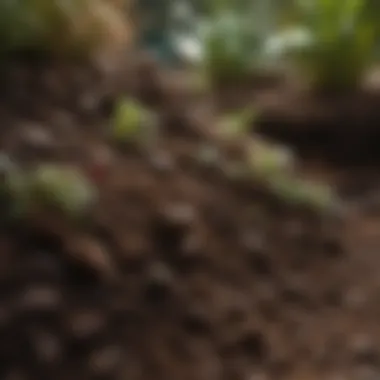
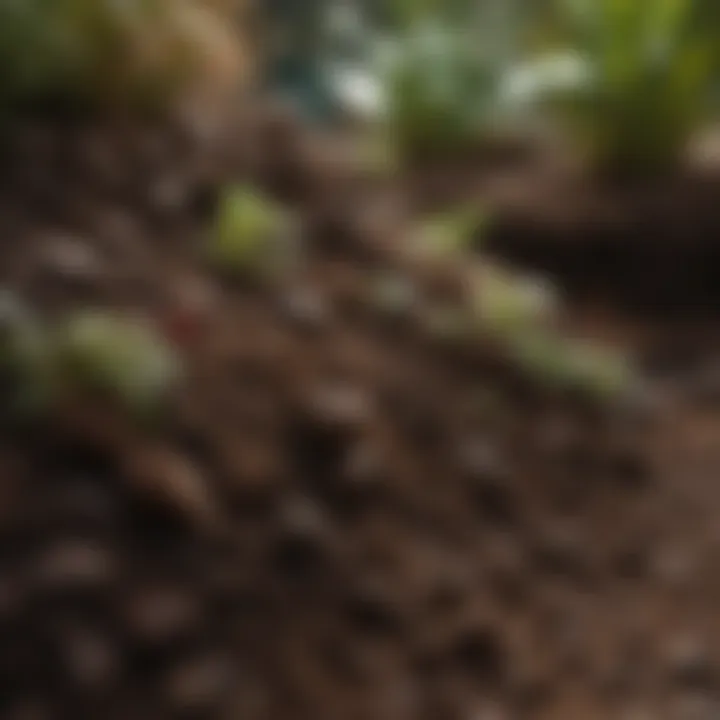
Intro
When it comes to gardening, one of the often overlooked aspects is the soil. For potted plants, the right soil composition can mean the difference between thriving greenery and dulled, lifeless foliage. Understanding what goes into a pot's soil is crucial to successful container gardening. With an abundance of options available, it's easy to feel overwhelmed. This guide is here to simplify that process. We’ll touch on what contributes to optimal garden soil for pots, the types suited to various plants, and the adjustments necessary for specific needs. Let’s dig in.
Gardening Know-How
Soil Composition Essentials
Getting to the Roots
Before we can grow, we need to understand what's beneath the surface. Potting soil is not just plain dirt. It typically consists of several components:
- Peat Moss: Great for moisture retention, it helps create a light, airy mix.
- Vermiculite or Perlite: These are vital for aeration and drainage.
- Compost: This provides natural nutrients, ultimately feeding your plant.
- Coconut Coir: An eco-friendly alternative to peat moss, good for water retention.
The right blend could vary, depending on the plants you are growing. Herbs, for example, thrive in lighter soil, while succulents prefer a more coarse mix to prevent root rot.
Drainage Capabilities
Avoiding Water Woes
One common pitfall for potted plants is poor drainage, leading to soggy roots and plant stress. To optimize soil drainage:
- Choose pots with drainage holes; this ensures excess water can escape easily.
- Incorporate materials like expanded clay pellets for extra drainage at the base of the pot.
- Water wisely; the top inch should dry out between watering sessions.
Tip: Always feel the soil before watering. If it's still moist, hold off a bit longer.
Nutrient Balance
Feeding Your Plants Right
Nutrients in soil can be just as pivotal as the soil's physical properties. A balanced mix typically includes nitrogen, phosphorous, and potassium—elements crucial to a plant’s growth. You might also consider adding slow-release fertilizers:
- Granular Fertilizer: Mix this in the soil before planting.
- Liquid Fertilizer: Use when you notice growth stalling or yellowing leaves.
Remember, different plants have varying nutrient requirements. Keep an eye on your plants and adjust as needed.
Addressing Common Challenges
The Garden Struggles
Even seasoned gardeners can hit snags in container gardening. Here are some common issues and remedies:
- Problem: Wilting Leaves
Solution: Check the soil's moisture content; this could be a sign of over or under-watering. - Problem: Yellowing Foliage
Solution: This could indicate a nutrient deficiency; consider boosting the fertilizer. - Problem: Pest Invasion
Solution: Inspect your plants regularly and remove any affected foliage immediately.
"The art of gardening is not just about planting but also about knowing how to respond to each plant's whisper."
End
Understanding Container Gardening
Container gardening has been gaining traction among homeowners and gardening lovers alike due to its flexibility and the unique way it allows for creativity in cultivating plants. It serves as both a practical approach to gardening and as a platform for personal expression. With limited space in urban settings or the need to beautify patios and balconies, container gardening becomes not just a necessity but an art form.
One significant aspect to note is the ability to control the environment of potted plants more effectively than in traditional garden beds. So much depends on the selection of pots, soil quality, and watering practices, creating a balance that can significantly influence the overall health of your plants. By using containers, gardeners can craft specific micro-environments tailored to each plant’s needs, harnessing ideal conditions for growth.
Concept and Benefits
Container gardening is as much about convenience as it is about beauty. For the novice, it presents a manageable way to get into gardening without a commitment to a full garden plot. It's less about digging and weeding and more about arranging and nurturing. The notion of "quick access" to garden labor rings true here; if it rains, you can quickly move pots under cover. This flexibility extends to placement, too. You can rearrange your setup according to the season, ensuring more sunlight in winter and shade in summer.
The benefits extend further, as containers also simplify pest and disease management. With plants in pots, it's easier to spot problems early and relocate afflicted plants than to deal with a sprawling garden bed that could harbor pests unseen. Additionally, a diverse array of plants can thrive together in a contained framework, allowing for the creation of captivating displays.
Here’s a succinct list of the advantages of container gardening:
- Space Efficiency: Ideal for small areas, from balconies to small yards.
- Accessibility: Easier on the back and knees; great for those with mobility issues.
- Control Over Soil: Minimize the impact of adverse soil conditions found in your yard.
- Aesthetic Appeal: Enhances outdoor or indoor décor with colorful and varied arrangements.
- Portability: Move pots according to plant needs or personal preference.
Types of Containers
Containers come in a myriad of forms and materials, each bringing its own charm and functionality into the equation. From traditional clay pots to modern creative variations, every choice affects how plants grow and interact with their environment. Below are some common types of containers suitable for garden soil:
- Terra Cotta Pots: Porous and natural, great for moisture control but can dry out quickly in hot weather.
- Plastic Pots: Lightweight and usually less expensive. They retain water well, making them a practical choice for beginners.
- Wooden Planters: Rustic look but can rot if untreated. Ideal for larger plants with deep roots.
- Hanging Baskets: Perfect for trailing plants; they add vertical interest but require regular watering.
- Fabric Pots: Increasingly popular; they encourage air circulation and promote healthier root systems.
Choosing the right container is essential not just for plant health but also enhances the overall design of your space. In essence, understanding the core principles and creative facets of container gardening sets the stage for success before even considering the soil or the specific plants to grow.
The Importance of Soil in Pots
Soil, in every sense of the word, is the lifeblood of plants—especially for those crammed into pots. When you're gardening in containers, the soil serves not just as a medium for growth but as a vital environment that influences air circulation, nutrient availability, and even water retention. It’s like the foundation of a house; if it’s not stable and healthy, the entire structure risks collapsing.
In the realm of container gardening, the importance of soil doubles down when considering the restricted space available to the roots. Unlike traditional gardening, where plants can stretch their roots deep into the earth, potted plants are confined to a limited volume of soil. This limitation heightens the need for quality soil that can support robust plant health.
- Optimal Nutrition: A nutrient-rich growing medium encourages healthy development. The right potting mix can make all the difference in achieving lush foliage and vibrant blooms.
- Soil Composition Influences Water Management: Good soil in pots has a balance of components that allow for proper drainage while retaining enough moisture to keep the plants hydrated.
- Microbial Activity: Healthy soil teems with beneficial microbes that break down organic matter and enhance nutrient uptake. Poor soil, on the other hand, can foster diseases and stunted growth.
As we delve deeper into the nuances of how soil impacts potted plants, it’s crucial to recognize two primary aspects:
Role of Soil in Plant Health
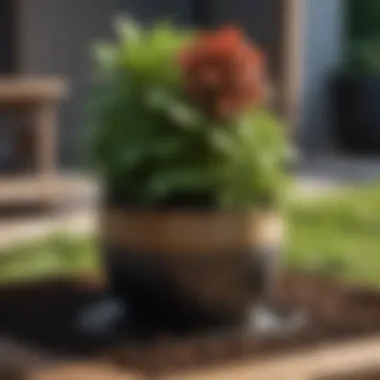
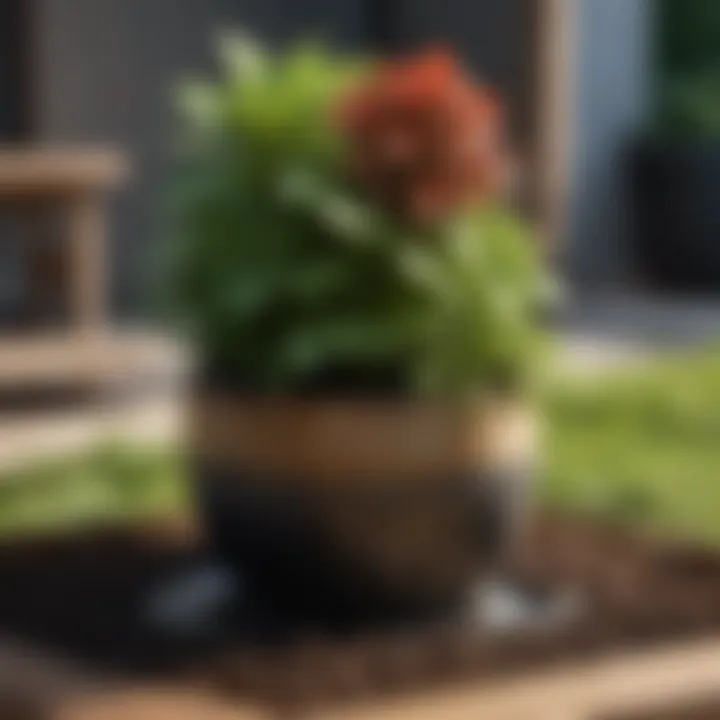
Understanding the role of soil in plant health truly begins with recognizing the intricate connection plants have with their growing medium. The soil must supply not only water and nutrients but also serve as an anchor for the roots. Each of these functions is vital:
- Nutrient Supply: The soil mix should have a blend of macronutrients like nitrogen, phosphorus, and potassium, which are essential for growth, alongside micronutrients such as magnesium and iron.
- Physical Support: Without solid ground to root into, plants cannot stand tall. Good quality soil holds onto moisture, allowing roots to penetrate and expand naturally.
Without adequate soil health, you risk stunted growth or even plant death. Say you have a fussy orchid; if the soil doesn’t support its specific requirements, the chances of rot or disease increase significantly.
Soil Drainage and Aeration
Container gardening brings unique challenges, especially regarding drainage and aeration. It's not just about the water leaving the pot; it’s about ensuring that air can circulate within the soil. Let’s look at this from two angles:
- Drainage: Poorly draining soil can lead to waterlogged pots, suffocating roots and paving the way for rot. On the flip side, overly fast-drying soils can leave your plants thirsty. Finding that middle ground is crucial— materials like perlite and vermiculite can help improve drainage without sacrificing moisture content.
- Aeration: Good aeration boosts root health by allowing essential oxygen to reach them. Roots need to breathe, and compacted soil will choke them, leading to poor growth and vulnerability to disease. Peat moss, when coupled with other components, creates space for air pockets—an often-overlooked advantage when mixing your potting soil.
"Soil is not just dirt; it’s a thriving community that supports life, almost like a miniature ecosystem. Your potting mix should be a reflection of that complexity and richness."
In summary, the significance of soil in pots cannot be overstated. Whether you're growing tomatoes on your balcony or ferns in your living room, the composition, drainage, and aeration of your potting soil play a pivotal role in determining the vibrancy and longevity of your plants.
Selecting the Right Soil Mix
Choosing the appropriate soil mix is crucial in the realm of container gardening. The right blend can mean the difference between flourishing plants and wilting leaves. When you're dealing with pots, the nuances of soil composition take on greater significance, owing to the limited space and inherent conditions of container life. An apt soil mix provides essential nutrients, supports healthy growth, and helps maintain adequate moisture levels.
The factors to consider here include drainage, retention capabilities, and the balance of nutrients required by specific plants. For instance, a pot filled with a dense, heavy soil may impede root development and lead to waterlogging, a condition that can suffocate plant roots. Conversely, an overly airy mix might not hold water sufficiently, leading to drought stress.
In summary, selecting the right soil mix involves understanding the basic components that contribute to a thriving plant environment and recognizing how these elements work together. Let's take a closer look at each component that forms a quality soil mix.
Components of a Quality Soil Mix
Peat Moss
Peat moss is a foundational element in many potting soils. Its structure retains moisture while still allowing air to circulate – an essential characteristic for container-grown plants. Highly absorbent, peat moss prevents soil from drying out too quickly.
However, one must also consider its environmental impact. Harvesting peat can strip away natural ecosystems. Therefore, while peat moss is widely favored, it encourages discussions about sustainability in gardening.
Vermiculite
Vermiculite is a lightweight mineral that expands when heated. It plays a critical role in improving aeration and drainage within potting soils. This material retains moisture and nutrients, ensuring they are available to the plant when needed.
Its light texture contributes to its popularity among gardeners looking for a well-balanced soil mix. However, it can break down over time, which might lead to a reduction in its beneficial properties.
Perlite
Perlite, a volcanic glass that gets heated and expanded, serves as another popular component. Its airy texture significantly enhances drainage and aeration in potting mixes. Plants with deep root systems particularly benefit from the presence of perlite in the soil, as it allows roots to breathe.
Yet, it’s not without drawbacks. Over time, perlite can become compacted, and its high cost compared to other materials can be a consideration for some gardeners.
Compost
Compost is often referred to as nature’s gold; it enriches soil mixes with organic matter. By incorporating decomposed plant materials, compost provides essential nutrients and beneficial microbes to the soil, promoting overall plant health. Its ability to improve soil structure allows for better moisture retention and aeration.
The downside is that not all composts are created equal. The source and preparation method greatly affect its quality. Without careful selection, the compost may introduce harmful pests or diseases to your pots.
Choosing Soil for Specific Plants
Once we understand the makeup of a quality soil mix, we can tailor our choices to specific plants. Different species have distinct needs shaped by their natural environments. When choosing soil for your pot, consider the specific characteristics of the plants you intend to grow.
Cactus and Succulents
Creating soil for cactus and succulents involves prioritizing drainage. These plants thrive in dry conditions and require a mix that quickly sheds excess water.
A popular formula includes a blend of sand, gravel, and organic matter. This results in a light, airy mixture that mimics their native arid environments. Although succulent soil can be easily assembled, neglecting drainage can lead to root rot – a common pitfall.
Herbs
When it comes to herbs, a balanced soil that holds both moisture and nutrients is essential. Most herbs prefer a light, loamy mix which allows for good drainage while still holding onto necessary nutrients.
By incorporating compost into the potting mix, you establish a nutritious foundation, providing a steady supply of nutrients. The catch is that herbs can be sensitive to nutrient imbalances, so regular monitoring is key.
Flowering Plants
Flowering plants often enjoy a more nutrient-rich blend. A quality potting soil containing peat moss, compost, and other nutrients will aid in flowering. However, it's also vital to ensure that this mix retains moisture without becoming overly saturated.
The unique feature of these plants is their varying needs. Some may require more acidic soil, while others prefer alkaline. In this case, a slight adjustment to the mix can cater to plant specifics.
Fruits and Vegetables
For fruits and vegetables, a well-rounded recipe that accommodates their nutrient requirements is crucial. A soil mix high in organic matter and enriched with slow-release fertilizers typically works wonders.
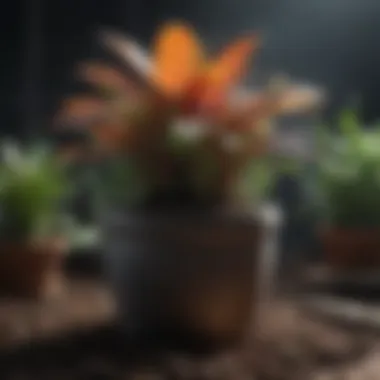
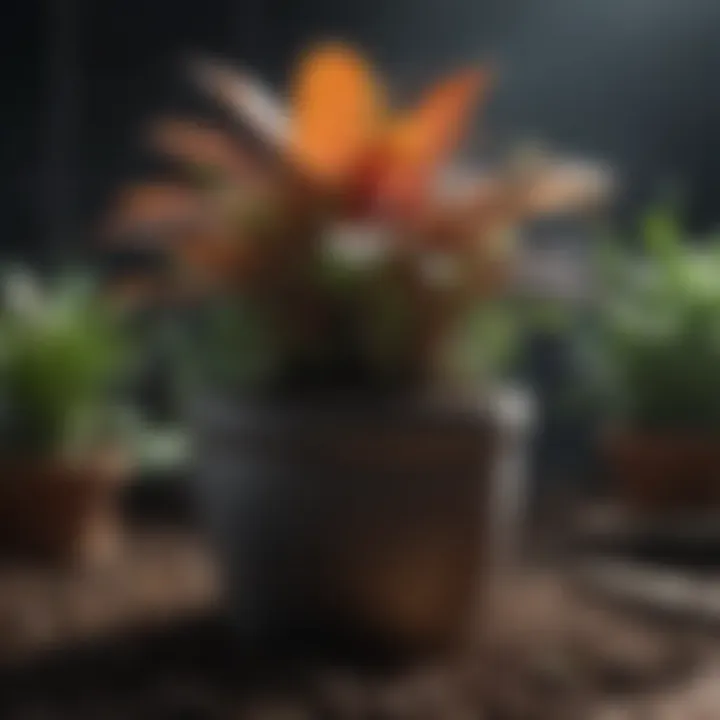
The goal here is ensuring that roots can access plenty of nutrients while maintaining healthy drainage. With containerized fruit-bearing plants, one also has to consider the pot size, as larger pots allow for deeper root growth.
Choosing the right soil mix is akin to selecting a home for your plants; the better the conditions, the more vibrant the life within. Understanding the components that make up quality soil, and tailoring them to suit individual plant needs, sets the stage for thriving greenery in any home.
Preparing the Soil for Potted Plants
Getting the soil ready for potted plants might seem mundane, but it’s the behind-the-scenes work that makes or breaks your garden. Plants living in pots rely heavily on the soil you provide them; it’s not just something to hold them up, but a reservoir of nutrients that keeps them thriving. With the right preparation, you set the stage for successful growth, healthier roots, and vibrant blooms. The focus here is on mixing your own potting soil and ensuring its sterility, aspects that many home gardeners overlook.
Mixing Your Own Potting Soil
Taking the time to mix your own potting soil can make a big difference in the health of your plants. Commercial potting mixes often contain a blend of ingredients, which can sometimes lack the essential nutrients plants need to flourish. Crafting your own soil blend lets you tailor it to the specific requirements of your plants.
A basic potting mix might include:
- Peat Moss: Provides moisture retention, helping keep plants hydrated.
- Perlite or Vermiculite: These ingredients enhance aeration and drainage, preventing the dreaded waterlogged conditions.
- Compost: Nutrient-rich, compost serves as slow-releasing fertilizer, giving your plants the food they need over time.
By mixing these components together, you can create a balanced soil that offers both moisture retention and drainage. For a well-rounded mix, some gardeners even throw in a handful of worm castings or bone meal to add an extra punch of fertility. While it may take a bit of effort upfront, the payoff in plant health is huge.
Pre-treating Soil for Sterility
Pre-treating your soil before use might sound finicky, but it’s an important step in preventing diseases and pests that can wreak havoc on your plants. Fresh soil, especially if sourced from outdoors, can harbor pathogens and unwanted critters. Sterilizing soil is a protective measure, ensuring your potted plants start off on the right foot.
One effective way to sterilize soil is:
- Baking: Spread your soil on a baking sheet and pop it in the oven at about 180°F (82°C) for 30 minutes. This process can kill off harmful organisms.
- Steam: If you can get your hands on a steam sterilizer, it’s another method that does the trick without drying out the soil too much.
- Microwave: If you’re short on time, microwaving damp soil in a container for a few minutes also works. Just ensure it reaches 180°F all the way through.
While it might seem like a hassle, sterilizing your potting soil minimizes risks significantly. Once the soil cools, it’s good to go. Your plants can then thrive without the fear of disease lurking in the dirt beneath them.
Remember: The effort you invest in soil preparation pays dividends. Healthy soil means healthy plants.
In summary, preparing soil for pots isn't just about putting dirt in a container—there’s art, science, and care involved. Mixing your own potting soil allows you to customize it for specific plants’ needs, while sterilizing ensures that they have a clean slate to work with. The simplest of actions can set you apart in your gardening game, ensuring you reap the rewards of lush foliage and vibrant blooms.
Incorporating Nutrients into Potting Soil
The garden soil in pots isn't just a home for plants; it’s their lifeline. Just as humans need a balanced diet, potted plants require a mix of nutrients to flourish. Incorporating nutrients into potting soil is essential to ensure that plants have access to everything they need to grow strong and healthy.
When we talk about nutrients for plants, we generally think of three primary elements: nitrogen, phosphorus, and potassium. These elements play distinct roles in plant development. Nitrogen is essential for leafy growth, phosphorus aids in root and flower development, and potassium helps with overall plant health and stress resistance. Including these nutrients and understanding how to manage them is what can set apart a lackluster garden from a thriving one.
Types of Soil Amendments
Soil amendments improve the quality of potting soil and help create a balanced environment suitable for plant growth. Let’s delve into the two main categories: organic and inorganic fertilizers.
Organic Fertilizers
Organic fertilizers are derived from natural sources, making them a favored choice for many gardeners. They contribute to the overall health of the soil by enhancing its biological activity. These fertilizers tend to break down slowly, releasing nutrients over time, which aligns wonderfully with the gradual growth needs of many plants.
One key characteristic of organic fertilizers is that they improve soil structure, which can enhance moisture retention and drainage. Think of compost, aged manure, and bone meal; they not only nourish the plants but also feed the soil itself.
While using organic fertilizers comes with many advantages, such as being environmentally friendly and improving soil health long-term, they do have some disadvantages. For instance, they can be less concentrated than their synthetic counterparts and might take longer to show results. In addition, the nutrient content can vary greatly based on the source and quality of the organic material.
Inorganic Fertilizers
In contrast, inorganic fertilizers are made from synthetic materials and provide a quick nutrient boost to your plants. They dissolve easily in water, allowing nutrients to be absorbed rapidly.
The key characteristic of inorganic fertilizers is their precision. They are often formulated to deliver specific nutrient ratios, which can be a game changer for gardeners looking to address particular deficiencies in their plants. For example, a fertilizer labeled as 10-20-10 will provide 10% nitrogen, 20% phosphorus, and 10% potassium.
However, while they offer immediate results, there are downsides. Using too much can lead to nutrient buildup in the soil, which may harm plants and eventually degrade soil structure over time. Moreover, they don’t enhance the biology of the soil, meaning over-reliance could lead to a less vibrant soil ecosystem over time.
Determining Nutrient Requirements
Balancing nutrients doesn't stop at merely choosing between organic or inorganic options; it involves a nuanced understanding of what your specific plants need. Each plant varies in its nutrient requirements based on its type, growth stage, and environmental conditions.
To effectively determine nutrient needs, consider conducting soil tests or observing plant behavior. Yellowing leaves could indicate a nitrogen deficiency, while weak root systems might point to inadequate phosphorus levels.
Implementing a careful nutrient management plan ensures that plants are neither starved nor overwhelmed with extra nutrients, creating healthier plants and a more productive garden overall.
"Understanding and meeting the nutrient requirements of your soil can significantly enhance the productivity of your potted plants."
Common Pitfalls in Potting Soil Choice
When it comes to potting soil, choosing the right mix can be the difference between a flourishing plant and a wilting one. Unsuitable soil hinders growth, stunting plants and causing unforeseen headaches for those who are just trying to cultivate an indoor herb garden or perhaps nurture some flowering plants. In this section, we will delve into the common mistakes that gardeners tend to make so you can steer clear and keep your plants healthy and happy.
Overly Dense Soil
One prevalent issue that gardeners face is using overly dense soil. This kind of soil can be a heavyweight in all the wrong ways. If the mixture is packed down tight, roots find it hard to stretch and explore. With this density, they may even suffocate, leading to stunted growth and reduced yield.
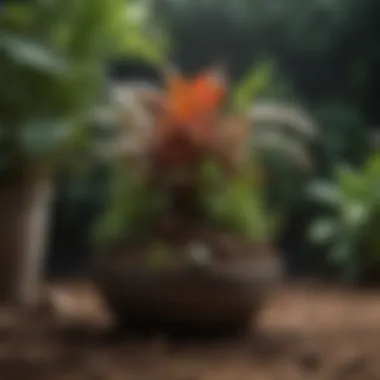
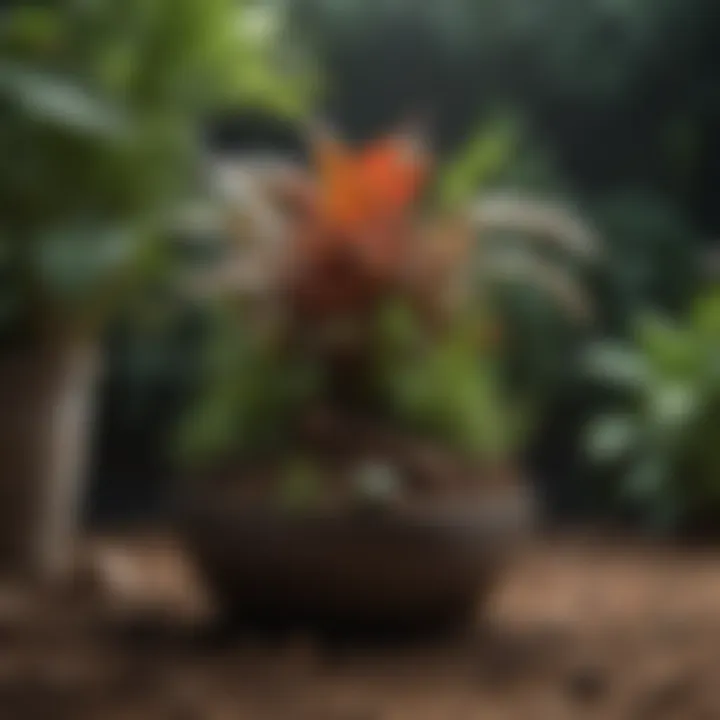
Dense soil reduces crucial air pockets that roots thrive on. Air is essential not just for respiration but for taking in water as well. Without sufficient oxygen, root rot can take place—a fate no plant deserves. To mitigate this problem, integrating light materials like perlite or vermiculite can be beneficial. These amendments will keep the soil fluffy and aerated, allowing your plants to breathe and flourish.
Remember: A good potting mix should feel like a sponge—light and airy, yet capable of holding moisture.
Inadequate Drainage
Another critical pitfall is failing to provide adequate drainage. Think of drainage as the exit door for excess water. Containers without sufficient drainage make it all too easy for water to sit at the bottom, leading to drowning plants. When this happens, root systems are deprived of oxygen, leaving them vulnerable to diseases that can ruin an entire crop.
Installing a drainage layer using gravel or clay shards at the bottom of your container can give your plants the breathing room they need. Moreover, using soil that contains inorganic materials like perlite or coarse sand will improve drainage even further.
To summarize how to avoid these pitfalls:
- Check for Density: Use light materials to keep soil airy.
- Assess Drainage: Ensure proper escape routes for excess water.
- Monitor Plant Health: Look for signs of stress, such as yellowing leaves or wilting, which hint at drainage issues.
In wrapping up this section, understanding these common misconceptions can make the world of difference in your gardening practices. By being aware of these mistakes, the process of choosing the right potting soil becomes clearer, keeping the focus on nurturing plants and enjoying the fruits of your labor.
Maintaining Soil Health in Containers
When you think about potting plants, it’s easy to get caught up in choosing the right container or picking the prettiest flowers. However, maintaining soil health in containers is the backbone of successful gardening. Good soil serves as a steady foundation, anchoring roots while delivering essential nutrients to plants. Without proper care, your garden soil can quickly turn into a barren wasteland, leaving you with droopy leaves and lackluster growth.
Watering Practices
Watering practices can make or break your garden, especially in pots. Unlike the expansive ground soil, potting soil can dry out swiftly or become waterlogged, leading to trouble. Knowing when and how much to water is crucial.
- Frequency: Generally, potted plants need a more frequent watering schedule than those planted in the ground. A good rule of thumb is to check the top inch of soil—if it’s dry, it’s time to water.
- Method: Instead of pouring water directly over the plant, consider watering around the base. This helps to avoid fungal issues and keeps the leaves dry.
- Time of Day: Early morning is often touted as the best time to water. This allows plants to absorb moisture before the sun’s rays get too hot.
- Drainage: Ensure your pots have drainage holes. Standing water is an invitation to root rot, a condition that can do away with your green friends swiftly.
Taking care of your watering routine helps create a balanced environment where plants can thrive.
"Watering is a dance—too much and you drown, too little and you wither."
Replenishing Nutrients Over Time
Just like we need our meals to stay energized, plants require a steady supply of nutrients to flourish. The soil in pots often depletes faster than in the ground due to restricted volume and quicker runoff. Here are some ways to keep your soil nutrient-rich:
- Fertilizing Regularly: Using organic fertilizers like compost or worm castings can put the goodness back into your soil. These options provide a slow-release source of nutrients, which is much healthier for your plants compared to heavy chemical fertilizers.
- Testing Soil: Consider testing your soil from time to time. DIY kits or local gardening centers can help you understand nutrient levels and pH. Each plant has its own quirks when it comes to nourishment; knowing where your soil stands will guide your feeding strategy.
- Top-Dressing: Adding a layer of fresh compost on top of the soil can significantly improve the nutrient content over time, making it easier for plants to absorb.
By being proactive about replenishing nutrients, you ensure your plants have the best chance for success. This keeps your adventures in container gardening both productive and fulfilling.
Sustainability in Potting Choices
Sustainability in potting choices has gained traction as both a crucial consideration for homeowners and a necessity for a healthier environment. As more individuals embrace indoor plants and container gardening, the implications of our choices become clearer. Practicing sustainability in gardening can reduce waste, decrease environmental impact, and contribute to a greater ecological balance. It's about selecting materials and methods that not only nurture our plants but also protect the planet.
One key element of sustainable gardening is the conscious selection of materials. Traditional potting soils often contain non-biodegradable components that may harm the environment. Conversely, employing eco-friendly materials can mitigate these issues. Treatments like organic fertilizers that not only nourish but also enhance soil health are recommended. Additionally, researching the source of these materials adds transparency and promotes ethical practices.
Eco-Friendly Materials
The shift towards eco-friendly materials is both a wise and necessary adjustment in modern gardening. These alternatives offer multiple advantages:
- Coconut Coir: Unlike peat moss, which is harvested from sensitive ecosystems, coconut coir is a sustainable by-product of coconut processing. It provides excellent aeration and retains moisture, making it a great addition for soil mixes.
- Compost: This organic waste product enriches the soil. Not only is it beneficial for plants, but it also reduces the accumulation of waste in landfills.
- Recycled Materials: Post-consumer products, such as shredded newspapers or cardboard, can be recycled into soil amendments. They improve drainage and retain nutrients, promoting a healthier soil ecosystem.
- Biodegradable Pots: For those who prefer hanging pots or planters, biodegradable options exist. These can break down naturally, lessening their environmental footprint.
By integrating these materials, gardeners encourage a thriving, eco-conscious approach that supports both plant health and sustainability.
Recycling Soil After Use
Recycling soil after use is another critical aspect of sustainable gardening. Many gardeners tend to dispose of old soil after a season, often leading to waste and additional chemical pollutants. Instead, reconditioning existing soil not only conserves resources but also enhances longevity and health in plants for future planting. Here are some practical steps:
- Soil Assessment: Before reusing soil, check for signs of nutrient depletion or compaction. If you notice any issues, it might need some amendments.
- Restoration Mix: Combine the old soil with fresh compost or organic matter to invigorate it. This will bring back vital nutrients.
- Sterilization: To kill any pathogens or pests, consider a low-heat treatment. Leaving soil in the sun for a few days can also help in this regard.
- Storing for Future Use: If you have leftover soil that's in good condition, store it in a breathable container, protecting it from moisture and pests.
Recycling soil reduces waste and allows you to maintain a thriving garden without constant reliance on new materials.
By embracing these sustainable practices, gardeners contribute to personal gardening success while positively impacting the environment.
Closure: Elevating Potting Practices
In the realm of container gardening, the significance of properly optimized potting soil cannot be overstated. As we round off this article, it’s essential to reflect on how keen attention to soil composition, nutrient balance, and drainage profoundly affects plant health and growth. An optimized soil strategy allows every gardener, whether a novice or seasoned expert, to cultivate vibrant plants that not only flourish but also add aesthetic appeal to their homes.
The choice of materials and techniques discussed in this article serves as a foundation for creating a thriving environment right in your pots. Just imagine those blooms bursting with life or vegetables ripening perfectly, all because of the conscious decisions you made during the soil preparation phase. It brings to the fore the idea that gardening is not merely about plants and pots; it is about the care and understanding we exhibit towards the ecosystem we're trying to nurture.
"With the right practices, every pot can become a miniature paradise of health and beauty."
Key Takeaways
- Soil Composition Matters: Using the right blend of peat moss, vermiculite, perlite, and compost can transform your garden pot into a fertile environment. This mix ensures good drainage and aeration, vital for root health.
- Ongoing Care is Essential: Regularly assessing the health of your soil and plants is essential. Nutrient replenishment through organic or inorganic fertilizers keeps your potting mix alive and thriving.
- Sustainability is Key: Considering eco-friendly materials and practicing soil recycling not only benefits your plants but also the planet.
- Customization for Plants: Different plants require different soil conditions. Tailoring the soil mix to the specific needs of your plants enhances growth potential.
Future Trends in Potting Soil Composition
The gardening landscape is evolving, and as such, future trends in potting soil composition are intrigued and promising. Innovations in soil technology, such as biodegradable options that reduce waste, are gaining traction. Here are some significant trends to keep an eye on:
- Use of Mycorrhizal Fungi: Incorporating beneficial fungi into potting mixes to enhance nutrient absorption and improve plant resilience.
- Smart Soil: The advent of soils embedded with monitoring technology for moisture and nutrient levels, providing real-time data to help gardeners optimize care.
- Urban Gardening Solutions: As more city dwellers embrace container gardening, soil mixes that cater to limited space and harsh environmental conditions are expected to emerge.
Understanding and adapting to these trends will not only elevate your gardening game but also align with a more sustainable and eco-conscious approach to gardening. Embracing these changes can empower you to not only grow better plants but also feel good about the choices you make.







